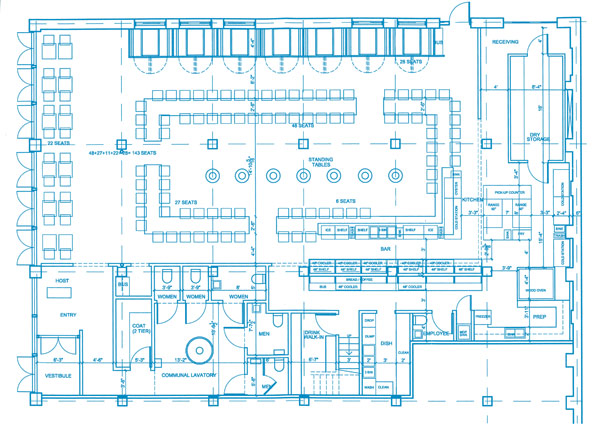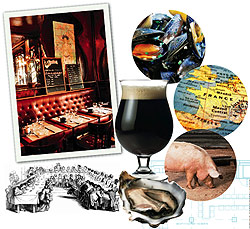

|
"Come in," says Paul Kahan. "You are about to see why I have dark circles under my eyes." With that, he ushers me into his Irving Park home, past the dog and two cats, past the record collection in the living room, and into the kitchen, a room that could be called homespun if it weren’t for a professional-size Viking stove. This kitchen is currently ground zero of Kahan’s biggest project to date, a 4,200-square-foot beer hall on West Fulton Market. I’ll call it Project X, since, at presstime, he and his three partners—Donald Madia, Terry Alexander, and Eduard Seitan—had yet to settle on a name. They’ve got until late June, when the place is slated to open.
Standing in the kitchen are Kahan’s wife, Mary, and a tall, congenial guy named Brian Huston, Project X’s intended chef de cuisine. Since January, Huston has been coming over every Monday to work on the menu in the Kahans’ kitchen, a place where the simple french fry requires weeks of experimentation. By early April, they have narrowed down the potential frying mediums: pork or beef fat, heated to 350 degrees.
On the laboratory’s chore list tonight are mussels, and, specifically, finding the best preparation for a Buchot variety harvested in Casco Bay, Maine. In weeks past, the two chefs have sautéed the meaty bivalves in a broth of white Belgian beer. The beer makes sense; after all, Project X will offer about 100 beers in bottles and another 12 on tap. The thinking now, however, is that white wine varieties could work better. The first batch comes out of the pot gleaming black and ready for eating, but a few samples are deemed "short on everything." More wine. Celery gets tossed into the broth, too—a suggestion from Mary, whose opinion clearly resonates. Minutes later, the resulting second batch is dumped into the bowl: @#$%! Now they’re undersalted and taste too much like wine. The alcohol is adjusted, salt is added, and a third batch is put over the flame.
As Kahan cooks and gently criticizes, I notice in his manner a pattern of threes. For the new establishment, he describes three menu basics: beer, oysters, and pork. And a philosophy based upon three values: food that’s seasonal, local, and simple. He doesn’t mention the most obvious trio; he doesn’t have to, for everyone knows there’s Blackbird on West Randolph, his fine-dining restaurant that puts him among top Chicago chefs; Avec, his crowd-pleasing small-plates wine bar next door; and now Project X, which aims not to strike a balance between its two predecessors, but to go beyond them—in scale if nothing else.

 |
Four days later, when I meet Kahan and Madia to tour the raw space, I am reminded that, at this level, design elicits at least as much handwringing as the mussels broth. Where Kahan can talk endlessly about the fresh farm goat butter he plans to serve, Madia obsesses over the wallpaper that will hang behind the hostess stand. The New York architect Thomas Schlesser’s blueprints for the space call for a rectangle of long walnut tables and tall ladder-back chairs. Diners will sit communally under 84 vintage globes, all opaque white and suspended from the ceiling. And, though on my visit I saw nothing but studs for walls and a cement floor, Madia described their vision—wallpapered modernism melded with brass taps, antique steins, and some nods to the history of the 120-year-old building. The history is important to the chef. As we climb to the mezzanine to examine the dry storage, Kahan mentions that his great-grandfather, a Russian "jobber," or wholesale food distributor, likely stocked his cart at this very building in the early 1900s.
The vision is impressive, but when the mention of costs comes up, an aura of mild panic creeps in. Project X has been in the works for two years now, and just when it’s time for it to launch, a whole crop of high-profile restaurants are slated to open. No one’s willing to talk dollars, but it’s clear that a lot of money is on the line, and despite having a James Beard-winning architect and a James Beard-winning chef on the payroll, the partners are doing a ton of heavy lifting—literally—themselves. Then there are the other unfinished details: two months out and still no name. Kahan isn’t crazy about the possibilities, which include New Monastery (too religious?); the Publican (too political?); and two French derivatives, Saison and Le Bon Fermier (too hard to pronounce?). "As much as we like to say we aren’t control freaks, we are," admits Madia.
Back to the mussels: The latest batch is ready and everyone digs in and agrees that they’re delicious—except Kahan, who gives the effort a C-plus. He’s similarly underwhelmed by some country ribs that, about an hour later, come off the grill tasting too sweet. Not to worry. Plenty of menu items have already been perfected, including deboned sardines topped with a green garlic salsa verde and grilled asparagus under a soft-poached duck egg. As Huston plates the tender asparagus stalks to the tune of Mavis Staples on the stereo, the chef slips back to his refrigerator and pulls out a bottle of Trappist Rochefort. He describes how the dark ale is brewed at a small Belgian monastery, and how his new venture is really about his love of beer, and I see for the first time what Paul Kahan looks like when he’s satisfied.
Photography: (Players, from left) Jessica Tampas Photography, Anthony Tahlier, Michael Stryder Photography (Brasserie) Bertrand Rieger/Getty Images; (Mussels) © Ryan Fox, (oyster) © Giuseppe Lancia, (pig) © Maria Jeffs, (map) © Isabelle Mory, (beer) © Ljupco Smokovski, all, istockphoto.com; (chair and plates) Megan Lovejoy



